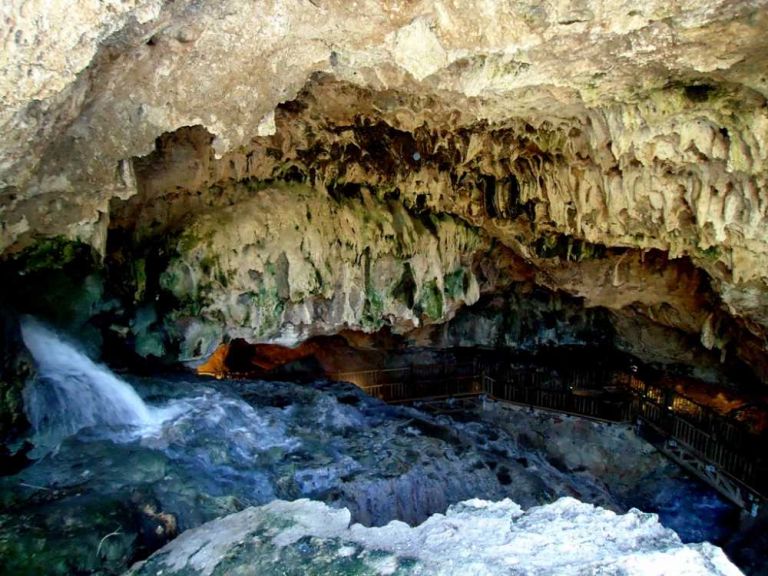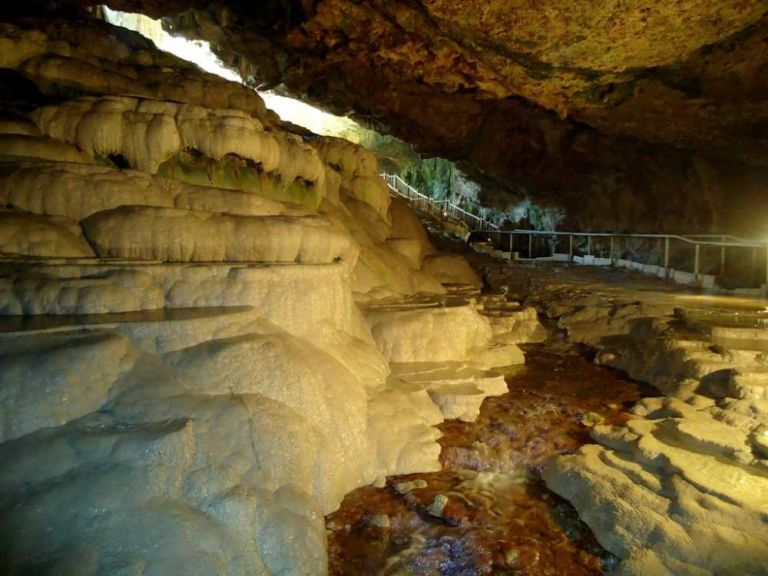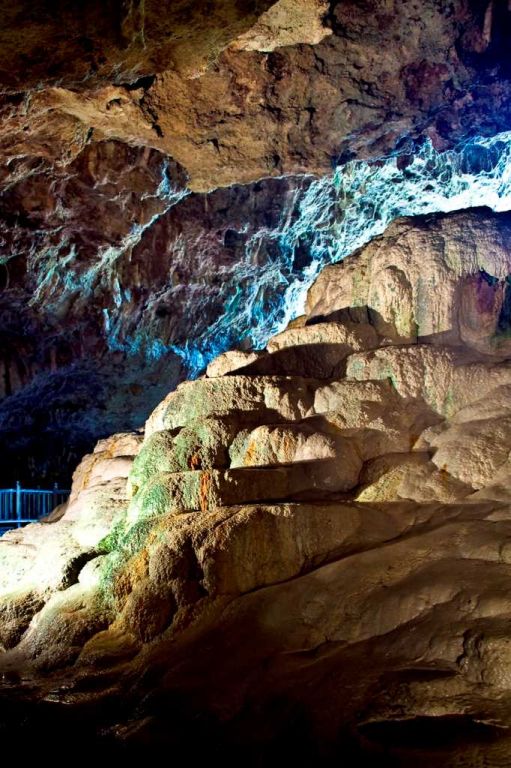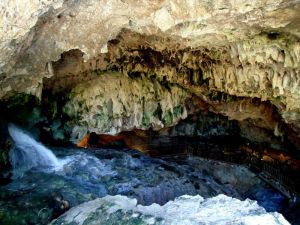The sea cave of Kaklik
The sea cave of Kaklik
The Cave of the Pigeons, It is one of the ideal options to witness the natural wonders of the sea. Don't forget to add this historic natural wonder to your list for an unforgettable cultural itinerary at sea! Of the other structures of the sea that must be seen The cotton travertine . The Ornaz Valley and ... The Israfil River We suggest you check out our stops as well. If you want to know more about the sailor. What Can Be Done? Where Does It Stay? and ... Where's Yenir? You can also check out our pages.
About the cave of Kaklik
About the Cave of the Pigeons, The cave is located in the town of Kaklık on the Denizli - Ankara highway. This cave is one of the areas of Denizli where groundwater is abundant. The cave is decorated with droplets, slopes and spires and has travertine steps similar to the travertine pools in Pamukkale. Therefore, it is also called "Little Pamukkale" or "Cave Pamukkale".
The area around the cave has been developed in order to offer more facilities to visitors. A nearby swimming pool, a small amphitheater, viewing areas, a cafeteria, and cafeterias allow visitors to have a good time. Kaklık Cave has been contributing to tourism for 21 years and is a fascinating natural wonder with its waterfalls, waterfalls, dams, thermal pools, green algae, a constant temperature of 32 degrees Celsius and a magical atmosphere.
Where's the sea urchin cave?
Where's the Sea Poop Cave? Kaklık Cave is located in Kaklık town of Honaz district, 30 km from the provincial center of Denizli on the Denizli - Ankara highway.
How do you get to the Poultry Cave?
How do you get to the Poop Cave? You can use the following methods to reach Kaklık Cave:
- The public transport: You can easily reach the cave by using the minibuses that regularly run from the maritime city center to Kaklık Mahallesi. Kaklık minibuses departing from the sea bus station are suitable to follow this route.
- The taxi: There are many taxis in Denizli. If you want to go to the cave by taxi, you can call a taxi by going to the taxi stops or using taxi applications.
- Special vehicle: If you have rented a car in Denizli or have your own car, you can use GPS or maps to follow the Denizli - Ankara highway to reach Kaklık Mahallesi in Honaz district. After reaching Kaklık Mahallesi, you can reach the cave by following the marked road in a northerly direction for about 3 kilometers.
Characteristics of the formation of Kaklık Cave:
Characteristics of the formation of Kaklık Cave:
-
The formation of the cave:
- I know. Kaklık Cave was formed as a result of a collapse in the roof of a large underground stream.
- I know. The formation of the traverten steps inside the cave was the result of the flow of spring water from the nearby bath in the form of a waterfall. -
The Light of the Cave:
- I know. When you think of a cave, you usually think of dark chambers. But the wide mouth of Kaklık Cave is quite bright inside because it receives sunlight during the day.
- I know. The reception of sunlight inside the cave has caused the formation of greenery and algae on the sides of the thermal water flowing over the travertines. -
The Unique Beauty of the Cave:
- I know. With these features, Kaklık Cave offers a unique beauty. This cave, where greenery, algae, thermal water and sunlight meet, is visually fascinating.
- I know. Once visitors enter the cave, they may not want to leave. Therefore, for those who visit Denizli, Kaklık Cave is definitely recommended as a place worth seeing.
Structural features of the cave?
The structural features of Kaklık Cave are:
-
The process of creation:
- I know. It contains a large mass of travertine. In addition, traverts similar to Pamukkale were formed as a result of the Kokarhamam Fountain (Haydarbaba Fountain), which is located immediately near the cave, flowing into the cave by making waterfalls. -
The Travertine Pools:
- I know. Traverten pools formed in steps in the cave still continue to develop today.
- I know. In addition, water leaking from the northern wall of the cave has created travertine walls. -
Light acquisition and plant cover:
- I know. Kaklık Cave has a wide circular mouth and receives sunlight during the day. As a result, algae and small caterpillars develop inside the cave.
- I know. The vegetation, which reflects different shades of green with changing light conditions during the day, enriches the aesthetic appearance of the cave. -
Drip, drip and drip:
- I know. Inside the cave there are droplets, hangings and dikits, which contribute to the aesthetic richness of the cave. -
Thermal water and springs:
- I know. There is an abundance of thermal water and springs inside the cave. Because these waters are clear, colorless, and smell of sulfur, they are thought to be good for certain skin diseases.
- I know. Kaklık Cave has been investigated at the request of the Governorate of Denizli and has significant potential as a natural wonder that will contribute to tourism.
Places to visit around Kaklık Cave
Places to visit around Kaklık Cave:
- The town of Kaklık: The town where Kaklık Cave is located is a nice opportunity to explore the quiet atmosphere and local life. You can walk the streets of the town and interact with the locals.
- The National Park of Mount Honaz: The Khonaz Mountain National Park, located near Kaklık Cave, is a great place for nature enthusiasts. Here you can go hiking, have a picnic, and climb to the top of Mount Honaz.
- The Maritime Center: After visiting Kaklık Cave, you may want to go to the center of Denizli and explore the city. You can take time to see important tourist attractions such as the Pamukkale Traverts in Denizli and the Ancient City of Hierapolis.
- The Baths of the Banquet: Karahayit Spa, located near Denizli, is famous for its thermal waters. You can relax here and enjoy the thermal waters.
- Traditional restaurants: You can try local delicacies in the traditional Turkish restaurants around Kaklık Cave. We especially recommend that you taste the typical dishes of Denizli.
These places and activities can make your visit to Kaklık Cave even more enjoyable.
Entrance fee to Kaklık Cave
Entrance fee to Kaklık Cave It's $15 as of 2023.
Does the Poop Cave Museum Card apply?
Museum card at the Cave of Cacti This is valid. It's not. Since it's affiliated with the municipality, you can pay the entrance fee and start touring the cave.
What does the poop cave smell like?
What does Poop Cave smell like? The cave contains an abundance of clear, colorless, sulfur-scented thermal water. This thermal water is also known to be good for some skin diseases. That's why he's in the cave. The smell of sulfur. It exists. Some of the visitors may find the smell heavy.
Kaklık Cave: The Mysterious World of Unique Travertine
A natural wonder hidden in the Kaklık neighborhood of the Honaz district of the Denizli province: Kaklık Cave. This enormous cave, which attracts thousands of local and foreign tourists every year, is dazzling with its unique travertine and natural beauty.
The cave of Kaklık The Art of Nature: The Travertine
The cave is like an art gallery of nature, decorated with hangings and spires. The travertine here resembles the unique white steps of Pamukkale. These natural formations, also called "Little Pamukkale" or "Cave Pamukkale" by visitors, were formed by the slow movement of water over the years.
The cave of Kaklık The Healing Power of Thermal Waters
The thermal water, which is abundant in the cave, is clear, colorless, and has a slight sulfur smell. This thermal water is believed to have positive effects on skin health. It is known that it can help treat certain skin diseases.
The cave of Kaklık A feast of natural illumination
Kaklık Cave attracts attention with its wide mouth that allows natural light to flow in. Therefore, it is often possible to see vegetation inside the cave. Drops, hangings, and dikes offer visitors a unique aesthetic of nature.
The cave of Kaklık Formation and structural features
The cave was formed by the collapse of a large underground trench. Duden-source is an active cave located at the edge of the sediment. The mass of travertine inside the cave is quite impressive.
The history of Kaklık Cave
Kaklık Cave was opened to the public in 2002 with the efforts of the Governorate of Denizli and the Provincial Directorate of Culture and Tourism to promote tourism. Facilities such as a swimming pool, a small amphitheater, viewing areas, a cafeteria and dressing rooms are available to visitors.
The cave of Kaklık Transport and the Environment
Kaklık Cave is located on the Denizli - Ankara highway, 30 km from the provincial center of Denizli, in the Kaklık neighborhood of Honaz district. The surroundings of the cave are surrounded by various geological formations and is an important research area for nature lovers and scientists.
Kaklık Cave continues to be a destination that captivates visitors with its natural beauty, thermal waters, and unique travertine. This unique cave, which attracts nature lovers and adventurers, promises an unforgettable journey into nature.










Değerlendirmeler